|
|
 |
|
Calanoida ( Order ) |
|
|
|
Lucicutiidae ( Family ) |
|
|
|
Lucicutia ( Genus ) |
|
|
| |
Lucicutia curta Farran, 1905 (F,M) | |
| | | | | | | Syn.: | Lucicutia longiserrata : Sars, 1925 (p.220, figs.F,M); Rose, 1933 a (p.195, figs.F,M); ? Mazza, 1962 (p.339); Grice, 1963 a (p.496); Grice & Hülsemann, 1965 (p.224);
Lucicutia ellipsoidalis Brodsky, 1950 (1967) (p.333, figs.F,M); Minoda, 1971 (p.37, Rem.); 1972 (p.326); Morioka, 1972 a (p.314); Hattori, 1991 (tab.1, Appendix); Yamaguchi & al., 2002 (p.1007, tab.1); Ikeda & al., 2006 (p.1791, Table 2); Homma & Yamaguchi, 2010 (p.965, Table 2); Homma & al., 2011 (p.29, Table 2, 3, abundance, feeding pattern: suspension feeders);
no Lucicutia curta : Grice & Hulsemann, 1965 (p.224) | | | | Ref.: | | | Farran, 1905 (p.44, figs.F); 1908 b (p.64); Lysholm & Nordgaard, 1921 (p.25); Farran, 1926 (p.277); 1929 (p.209, 264); Wilson, 1932 a (p.129, figs.F); Rose, 1933 a (p.197, figs.F); Jespersen, 1934 (p.104, Rem.); Wilson, 1942 a (p.192, fig.M); Vervoort, 1957 (p.128, figs.F,M); Tanaka, 1963 (p.41, figs.F,M, Rem.); Vervoort, 1965 (p.114, Rem.); Hülsemann, 1966 (p.709, figs.F); Heptner, 1971 (p.123, figs.F,M); Ali-Khan & Ali-Khan, 1982 (p.265, figs.F); Roe, 1984 (p.358); Razouls, 1994 (p.151, figs.F,M); Chihara & Murano, 1997 (p.830, tab.5, Pl.124: F,M); Bradford-Grieve & al., 1999 (p.883, 945, figs.F,M); Bradford-Grieve,1999 b (p.97, figs.F,M, Rem., figs.176, 191); Boxshall & Halsey, 2004 (p.133: F; p.134: M); Vives & Shmeleva, 2007 (p.329, figs.F,M, Rem.) | 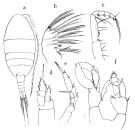 issued from : O. Tanaka in Publs Seto Mar. Biol. Lab., 1963, XI (1). [p.42, Fig.168]. Female: z, habitus (dorsal); b, Mx2; c, Mxp; d, P1; e, P5. Male: P5.
|
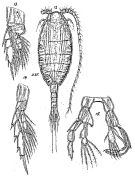 Issued from : G.O. Sars in Résult. Camp. Scient. Prince Albert I, 69, pls.1-127 (1924). [Pl.LIX, figs.12-15]. As Lucicutia longiserrata. Female: 12, habitus (dorsal); 13, P1; 14, P5. Male: 15, P5.
|
 Issued from : K.A. Brodskii in Calanoida of the Far Eastern Seas and Polar Basin of the USSR. Opred. Fauna SSSR, 1950, 35 (Israel Program for Scientific Translations, Jerusalem, 1967) [p.333, Fig.231]; As Lucicutia ellipsoidalis. Female (from NW Pacific): habitus (dorsal and lateral left side); S1, P1; S5, P5. Male: habitus (dorsal); S5, P5 (Ri : right leg; Le: left leg.
|
 Issued from : K. Hülsemann in Bull. Mar. Sc., 1966, 16 (4). [p.720, Fig.80]. Female: 80, P5.
|
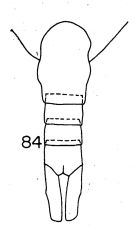 Issued from : K. Hülsemann in Bull. Mar. Sc., 1966, 16 (4). [p.722, Fig.84]. Female: 84, urosome (dorsal).
|
 issued from : M.V. Heptner in Trudy. Inst. Okeanol., 1971, 92. [p.124, Fig.25]. Female (from Kuril-Kamchatka Trench). pbs, spine-like on outer margin of baipod of P1; habitus with spermatophore (lateral). Male: pbs V, inner distal margin of basis of left P5 with row of spinous processes around inner distal angle.
|
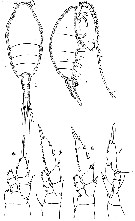 issued from : G.P. Farran in Ann. Rep. Fish. Brch., Ireland, 1902-1903, II, App. 2, 1905. [Plate XII, Figs.1-7]. Female (from W ireland): 1-2, habitus (dorsal and lateral, respectively); 4-6, P1 to P3; 7, P5.
|
 issued from : G.P. Farran in Ann. Rep. Fish. Brch., Ireland, 1902-1903, II, App. 2, 1905. [Plate XII, Fig.3]. Female (from W ireland): 3, A1.
|
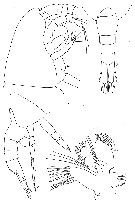 issued from : W. Vervoort in B.A.N.Z. Antarctic Reseach Expedition, Report-Ser. B, Vol. III, 1957 [Fig.115]. Female (from 61°44'S, 77°59'E): a, cephalosome (lateral); b, posterior part cephalothorax and urosome (dorsal); c, idem (lateral); d, left Mx1.
|
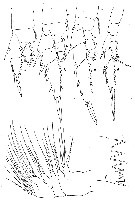 issued from : W. Vervoort in B.A.N.Z. Antarctic Reseach Expedition, Report-Ser. B, Vol. III, 1957 [Fig.116]. Female: a, right P1 (anterior); b-d, P2 to P4 (left legs, posterior); e, left Mx2; f, Md (citting edge).
|
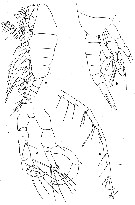 issued from : W. Vervoort in B.A.N.Z. Antarctic Reseach Expedition, Report-Ser. B, Vol. III, 1957 [Fig.117]. Male: a, habitus (lateral); b, posterior part cephalothorax and urosome (lateral); c, P5 (rt = right leg; lt = left leg); d, distal part of left A1
|
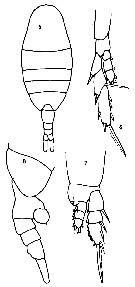 issued from : S. Ali-Khan & J. Ali-Khan in Crustaceana, 1982, 43 (3). [p;266, Figs.5-8]. Female (from 24°09'N, 64°27'E): 5, habitus (dorsal); 6, P5; 7, P1; 8, last thoracic segment and urosome (lateral, right side).
|
 Lucicutia curta Lucicutia curta female: 1 - Characters following not combined : Prosome about 3 times longer than urosome. Cephalosome with slightly projecting and rounded anterior corners and well developed lateral spinous projections; anal somite about as long as wide; caudal rami 11.7 times longer than wide and bowed outwards at base, leaving elliptical space between rami proximally. 2 - P1 with 3-segmented endopod. 3 - Cephalosome without lateral spinous projections. 4 - Genital double-somite symmetrical (dorsal view). 5 - Anal somite much shorter than caudal ramus. 6 - P5 with 3-segmented endopod. 7 - Characters not combined between distal 3 to 4 segments of A1 reaching beyond tip of caudal ramus and body length less than 3mm. 8 - Cephalosome without projections. 9 - Terminal setal element of P5 about equal to length of 3rd exopodal segment; body length over 2 mm. 10 - Caudal rami t 3 to 4 times longer than wide.
|
 Lucicutia curta Lucicutia curta male: 1 - P1 with 3-segmented endopod. 2 - Cephalosome without lateral projections. 3 - Right A1 reaching at most 2 segments beyond tip of caudal rami. 4 - Caudal rami at most 7 times longer than wide. 5 - Inner margin of basis of both P5 without pointed process; endopod of right P5 -2 segmented. . 6 - Caudal rami about 3 to 4 times longer than wide.
|
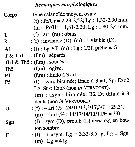 Issued from : C. Razouls in Ann. Inst. océanogr., Paris, 1994, 70 (1). [p.151]. Caractéristiques morphologiques de Lucicutia curta femelle et mâle adultes. Terminologie et abbréviations: voir à Calanus propinquus. Nota: Des différences existent entre les diverses descriptions portant sur les P5 des femelles et des mâles.
| | | | | Compl. Ref.: | | | Pearson, 1906 (p.25) Lysholm & al., 1945 (p.35); Sewell, 1948 (p.503, 567, 569); C.B. Wilson, 1950 (p.255); Fagetti, 1962 (p.29); De Decker & Mombeck, 1964 (p.13); Furuhashi, 1966 a (p.295, vertical distribution in Oyashio region, Table 6, 10); Grice & Hulsemann, 1967 (p.17); Park, 1970 (p.477); Roe, 1972 (p.277, tabl.1, tabl.2); Apostolopoulou, 1972 (p.328, 361); Björnberg, 1973 (p.343, 387); Vives & al., 1975 (p.49, tab.II, XII); Deevey & Brooks, 1977 (tab.2); Vives, 1982 (p.293); Kovalev & Shmeleva, 1982 (p.84); Tremblay & Anderson, 1984 (p.5, Rem.); Scotto di Carlo & Ianora, 1983 (p.150); Scotto di Carlo & al., 1984 (1042); Lozano Soldevilla & al., 1988 (p.59); Hopkins & Torres, 1988 (tab.1); Errhif & al., 1997 (p.422); Pancucci-Papadopoulou & al., 1990 (p.199); Scotto di Carlo & al., 1991 (p.270); Shih & Young, 1995 (p.70); Hure & Krsinic, 1998 (p.102); Voronina & Kolosova, 1999 (p.71); Lapernat, 1999 (p.21, 55); 2000 (tabl.3, 4); Razouls & al., 2000 (p.343, Appendix); Seridji & Hafferssas, 2000 (tab.1); d'Elbée, 2001(tabl. 1); Lapernat & Razouls, 2001 (p.123, tab.1); Holmes, 2001 (p.17); Hsiao & al., 2004 (p.326, tab.1); Lan & al., 2004 (p.332, tab.1); Kazmi, 2004 (p.228); Shimode & al., 2005 (p.113 + poster); Koppelmann & Weikert, 2007 (p.266: tab.3); Dur & al., 2007 (p.197, Table IV); Schnack-Schiel & al., 2008 (p.1045: Tab.2); Gaard & al., 2008 (p.59, Table 1, N Mid-Atlantic Ridge); Galbraith, 2009 (pers. comm.); Licandro & Icardi, 2009 (p.17, Table 4); Lan Y.-C. & al., 2009 (p.1, Table 2, % vs hydrogaphic conditions); Park & Ferrari, 2009 (p.143, Table 4, Appendix 1, biogeography); Mazzocchi & Di Capua, 2010 (p.426); Medellin-Mora & Navas S., 2010 (p.265, Tab. 2); Hsiao S.H. & al., 2011 (p.475, Appendix I); Hirai & al., 2013 (p.1, Table I, molecular marker); Lidvanov & al., 2013 (p.290, Table 2, % composition); Belmonte, 2018 (p.273, Table I: Italian zones) | | | | NZ: | 18 | | |
|
Distribution map of Lucicutia curta by geographical zones
|
| | | | | | | | | | | | | | | 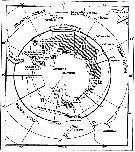 issued from : W. Vervoort in B.A.N.Z. Antarctic Reseach Expedition, Reports - Ser. B, Vol. III, 1957 [Fig.114] issued from : W. Vervoort in B.A.N.Z. Antarctic Reseach Expedition, Reports - Ser. B, Vol. III, 1957 [Fig.114]
Chart showing the geographical distribution (white triangle) in the seas surrounding the Antarctic continent.
Nota: In this chart the area frequented by whaling vessels has been hatched. The Antarctic circle (66°.5 S) has been drawn as a broken line. The numbers I to VI refer to the sectors into which the Antarctic seas are divided according to Mackintosh (1942) (after Vervoort, 1951). |
| | | | Loc: | | | Antarct. (Peninsula, Weddell Sea, Indian, SW Pacif.), South Africa (E), Congo, G. of Guinea, off NW Cape Verde Is., off Mauritania, Morocco-Mauritania, Canary Is., off Madeira, Azores, Caribbean Sea, Caribbean Colombia, G. of Mexico, off Bermuda (Station "S"), Sargasso Sea, Woods Hole, off E Nova Scotia, ? Bay of Baffin, S Iceland, off W Ireland, off W Scotland, Bay of Biscay, off W Cape Finisterre, Ibero-moroccan Bay, Medit. (Alboran Sea, NW Basin, Ligurian Sea, Tyrrhenian Sea, Strait of Messina, off Malta, Adriatic Sea, Ionian Sea, Aegean Sea, Lebanon Basin), Arabian Sea, Indian (W, SW, S, subtropical convergence), Philippines, China Seas (East China Sea, South China Sea), Taiwan Strait, Taiwan (SW, E, NW), Japan, off Sanriku, off Hokkaido SE, Kuril-Kamchatka Trench, Station Knot, Kuril Is., Bering Sea, S Aleutian Basin, off S & SE Aleutian Is., off British Columbia, Pacif. (tropical), Hawaii, W Colombia, N Chile, New Zealand (off N North Island, NW) | | | | N: | 71 | | | | Lg.: | | | (1) F: 2,25; (16) F: 2,45; (21) F: 2,6-1,9; M: 2,4-1,8; (22) F: 2,6-2,5; M: 2,4; (23) F: 2,9-2,55; M: 2,6-2,3; (25) F: 2,57-2,34; M: 2,3; (26) F: 2,34; M: 2,05; (35) F: 2,52-2,4; M: 2,3-2,15; (38) F: 2,4-2,04; M: 1,98-1,84; (45) F: 2,4-2; (199) F: 2,28-1,98; M: 2,13-1,9; (208) F: 2,6; M: 2,32; (340) F: 2,1; (402) F: 2,5; (909) M: 1,9; {F: 1,90-2,90; M: 1,80-2,60}
| | | | Rem.: | epi- to bathypelagic (320-4000 m).
Sampling depth (Antarct.) : 500-1000 m. Sargasso Sea: 500-2000 m (Deevey & Brooks, 1977, Station "S"); 1030-1646 m at Station S1 (SE Hokkaido) in the Oyashio region.
According to Hülsemann (1966, p.711) the 3-segmented endopod of P1 distinguishes this species from L. longiserrata.
After Lapernat & Razouls (2002, p.19) the Itoh's index value = 718.2 (number of teeth: 10). | | | Last update : 07/12/2020 | |
|
|
 Any use of this site for a publication will be mentioned with the following reference : Any use of this site for a publication will be mentioned with the following reference :
Razouls C., Desreumaux N., Kouwenberg J. and de Bovée F., 2005-2025. - Biodiversity of Marine Planktonic Copepods (morphology, geographical distribution and biological data). Sorbonne University, CNRS. Available at http://copepodes.obs-banyuls.fr/en [Accessed December 26, 2025] © copyright 2005-2025 Sorbonne University, CNRS
|
|
 |
 |
















